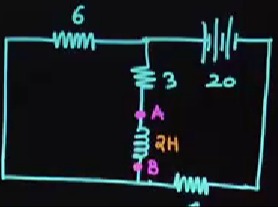Question
Question: The circuit diagram shows a 20V battery connected across a parallel combination of two branches. Bra...
The circuit diagram shows a 20V battery connected across a parallel combination of two branches. Branch 1 consists of a single 6 Ohm resistor. Branch 2 consists of three resistors in series: a 3 Ohm resistor, a 2 Ohm resistor, and a 1 Ohm resistor. Points A and B are the terminals of the 2 Ohm resistor, which is part of the series branch. What is the potential difference between points A and B?

20/3 V
10/3 V
6 V
20 V
20/3 V
Solution
The circuit consists of a 20V battery connected across a parallel combination of a 6 Ohm resistor and a series combination of 3 Ohm, 2 Ohm, and 1 Ohm resistors. The total resistance of the series branch is 3+2+1=6Ω. The current through this series branch is I=V/Rseries=20V/6Ω=10/3 A. Points A and B are the terminals of the 2 Ohm resistor. The potential difference across A and B is the voltage drop across the 2 Ohm resistor, which is VAB=I×R2Ω=(10/3 A)×(2Ω)=20/3 V.
